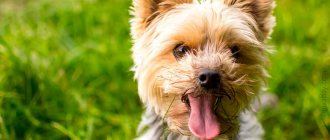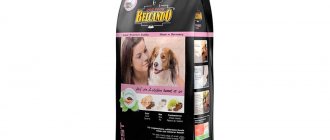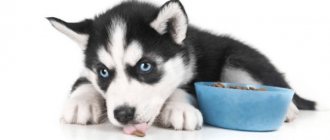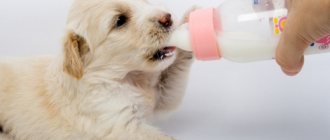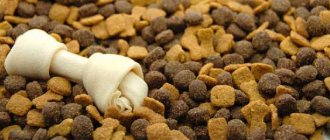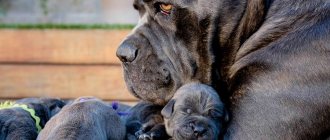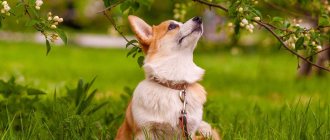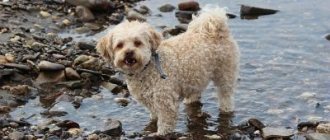Poodles are beautiful, graceful and elegant animals. To stay in good shape, they need to eat a balanced diet. When compiling a diet, you need to take into account the characteristics of this dog breed: a tendency to food allergies, obesity and begging.
Recommendations from dog handlers and veterinarians will help you choose the right menu for your pet. Then he will grow up healthy and will always look great.
Feeding dry food
Ready-made food is represented not only by dry granules, but also by wet canned food. From the variety of products in the store, you need to choose only those that belong to the premium class and higher - the economy segment will only harm your dog’s health.
Don't forget about water. A fresh and clean supply of water should always be available. Lack of fluid can lead to the development of kidney and liver disease.
The volume of a serving of finished food is calculated based on the manufacturer’s recommendations on the packaging, taking into account weight and age. Until 4 months of age, puppies are fed food labeled “puppy”. Then you can enter “junior”, but do it gradually.
Pets are transferred to “adult food” based on their breed variety:
- toy and miniature poodle - after changing teeth;
- small – after 10 months;
- big - after a year.
Many large manufacturers of premium food and higher have breed lines of food, with specified recommendations for transferring puppies to a new age type of food.
How to choose dry food
When choosing ready-made food, you should always be guided by the rule - cheap economy-class food is not suitable for complete nutrition for dogs. Even if the manufacturer claims that red and green granules are vegetables and fruits, the owner must remember that this is a dye. Such a chemical additive will harm your pet and cause allergies.
When choosing food, pay attention to the country of manufacture - an American diet produced, for example, in Poland, will be inferior in quality to the original.
We also performed a detailed analysis of the following feeds: Proplan, Monje, Dog Chow, Brit.
When to change food
- The dog has obvious signs of an allergic reaction: scabies, running eyes, hair falling out or dulling. It is necessary to exclude all possible allergens, primarily food ones. It is worth choosing another food from the line of hypoallergenic, medicinal or holistic;
- a disease requiring dietary or special nutrition has been diagnosed;
- the dog refuses food;
- the physiological state has changed: pregnancy, growing up or old age.
Photo: pxhere.com
Basic care rules
In order for your puppy to grow up healthy and happy, you need to care for him by following some rules:
- In the first days, be extremely attentive to the puppy and be affectionate with him. It was hard for him to move to a new house; he misses his mother and brothers. You must show him that you do not pose any danger, but on the contrary.
- If there are children in your house, then it is worth explaining to them that the animal is not a toy. You should not disturb him while he sleeps or pull his paws or ears. Show how to properly handle your new pet.
- The pet must have its own place to sleep and rest. Don't disturb him if he settles on it to catch his breath.
- The dog should have its own toys. As he grows up, he will have a need to chew on something and play with something. It would be better if it were his things than yours.
- Make sure that there are no things valuable to you or anything small that are dangerous for him on the floor or in the dog’s access area.
- Start teaching him his name and hygiene procedures: trimming his nails, cleaning his ears, rubbing his eyes, and checking his teeth. He must get used to the fact that such things will be repeated regularly.
- When walking outside, do not let your puppy pick up any objects from the ground, especially not eat or chew them. Do not let your dog off the leash unless you are sure that it is accustomed to you and will not rush after the first car or cyclist.
- The puppy should always have clean water freely available.
- Do not forget how many times a day you need to feed the puppy, and also that gradually the number of meals should be increased to twice a day.
Natural diet
Rules for cooking natural food:
- products can be either raw or thermally processed;
- raw meat should be pre-frozen in the freezer;
- cooked food should be at room temperature;
- Depending on the size of the animal, the food is cut into pieces.
What should be included in a natural diet:
- meat: beef, turkey;
- cereals (rice and buckwheat);
- meat by-products - only as an addition;
- fish – marine species, cleaned of bones. Boiled. Replace meat once or twice a week;
- fermented milk products – low fat content (up to 9%);
- vegetables and fruits – raw or stewed;
- oils and vitamin supplements.
Each new product is introduced gradually and little by little, observing the reaction of the dog’s body.
Natural nutrition requires constant preparation of a new fresh portion, which can be stored in the refrigerator for no more than two days. To make the process easier, you can prepare home-made canned food: mince meat, offal and vegetables, adding vitamins and oil. The minced meat is packaged and frozen. Immediately before feeding, warm up, adding cereal and fresh food.
Menu for the week
| Day of the week | Menu |
| Monday |
|
| Tuesday |
|
| Wednesday |
|
| Thursday |
|
| Friday |
|
| Saturday |
|
| Sunday |
|
I wonder if poodles eat quail eggs?
When is weaning from the mother?
In nature, the mother begins to wean the puppies when they are 3-4 weeks old. Breeders do this when the offspring reaches a month old.
IMPORTANT!
Weaning should not happen immediately; you cannot simply tear the dog away from its mother’s milk. Just start limiting the puppies from feeding them, for example, by taking the dog to an area where the babies cannot go. Introduce complementary foods.
What not to feed
To avoid allergies, exclude the poodle from the diet or introduce with caution:
- chicken meat;
- soy products;
- corn;
- yeast products;
- wheat.
Products are strictly prohibited:
- sweet, smoked, with lots of spices;
- tubular bones. For miniature poodles and toys, any type of bone is prohibited;
- honey – high risk of allergies;
- food sweeteners (xylitol);
- grapes, raisins, apricots and plums;
- salt.
If a dog is not eating well , but continues to remain active and cheerful, this is not a cause for concern. Perhaps your poodle is not getting enough exercise or the food in his bowl is not fresh. It's worth waiting until your next meal to make sure everything is ok. There is no need to increase the portion.
If your dog looks sick and lethargic, consult a doctor.
1st Choice Breeders for miniature breeds with chicken (20kg)
The best option among super-premium feeds. It consists of high-quality meat, vegetables, and does not contain unnecessary third-rate components and by-products. The composition does not contain taste or smell enhancers or other artificial additives.
The price per kilogram (366 rubles/kg) is budget-friendly for a product of this quality. Product, there is a huge range of food for small breeds with other tastes, hypoallergenic types that are suitable for animals with a tendency to allergies.
pros
- There is no unpleasant smell, the animal’s mouth does not smell after eating;
- The condition of the coat improves;
- Does not cause digestive upset, suitable for animals with a weak gastrointestinal tract;
- Each product in the line is balanced according to the age of the animal for which it is intended (this product for adult miniature dogs contains the required 22% protein);
- Does not cause allergies;
- Convenient packaging with a clasp, the product does not run out.
Minuses
- It has the form of granules, which are much more difficult to digest when not chewed;
- Difficult to find in pet stores.
What to feed a poodle puppy
| Age (number of feedings) | Nutrition |
| 4-5 weeks (6-8) | In addition to mother's milk, you can start complementary feeding: formula milk, cottage cheese, porridge, puppy food. |
| 2-3 months (4-5) |
|
| 4 months (3) | The diet remains the same; for large and small poodles the portion size is increased. For toys and dwarfs, the portion is not increased, but one more feeding per day is added if necessary. |
| 4-6 months (3) | Fish and offal, vegetable oil are introduced. Puppies are transferred to a “junior” diet of dry food. |
| 6 months – 1 year (2 or 3) | The set of products is saved by empirically determining the serving size. |
Watch Marsik and Velvet the toy poodle get their first feeding.
And here is the first independent feeding.
How many times a day?
By about 2 months, a poodle puppy is already mentally ready to separate from the family and move to a new owner. But this does not mean that his body is ready for a sudden change in diet. Find out more about the menu features from the breeder and feed the dog over the next two weeks.
Up to 3 months, food should be six times a day, from 3 to 6 months - four times a day, from six months to a year - three times a day, after a year the poodle can be switched to constant two meals a day.
What to feed an adult poodle
Interestingly, the serving size of poodles of various sizes does not depend directly on their weight. Smaller representatives of the breed require more feed per 1 kg of their weight. In addition, the dog’s activity, temperament and age will also affect the portion size.
| Diet (approximately) | Large (royal) (g/day) | Small (g/day) | Dwarf and toy (g/day) |
| meat and lean trimmings | 450-500 | 300-350 | 250 |
| cereals | 350-500 | 150 | 50 |
| vegetables fruits | 300 | 200 | 150 |
| eggs (boiled) (pcs.) | 1-2-3 times a week | 1-2 times a week | 1 time per week |
| sour milk | 250 | 150 | 100 |
| dry bread or crackers (pcs.) | 3 - after meals (you can bones) | 2 | 1 |
Small poodles need to be fed more frequently and in smaller portion sizes. With a natural diet, additional vitamin complexes are needed to provide the dog with the necessary substances. On a ready-made diet, such feeding is not required.
This little guy can't wait to eat.
Big (royal)
The main feature of nutrition is to prevent overfeeding and, as a result, obesity of the animal. The dog should remain stately and slender, the ribs should be palpable and not covered in fat.
Mini (dwarf)
These dogs are very active, smart and cunning. They are big gourmands, are constantly looking for tasty treats and are ready to understand everything from the ground up. You should strictly monitor your pet’s diet and remove bowls immediately after eating.
Toy
Most prone to allergies and overeating. These babies constantly ask for food from the owner’s table, but they also get fat faster than other relatives.
Small
Needs constant activity and a balanced diet. Avoid frequent feeding with additional treats - they quickly get used to it and refuse the main food.
Development by months
How does a poodle puppy develop from 1 to 12 months:
| Puppy age | Description | Size | Weight |
| 1 month | The puppy is just learning to navigate in space. At this time he is strongly attached to his mother and brothers. It is not yet possible to transfer it to a new home. This should have been done earlier, but now we have to wait. It's time to start weaning the puppy little by little from its mother. | About 15 cm | 1.2 kg |
| 2 months | Now is the time when it is easiest for a baby to get used to something. It's time to hand it over to its new owners. It’s also time to start accustoming him to a collar, brush, leash and start training him. This is also the time to start toilet training. | 17-20 cm | 2.5 kg |
| 3 months | "Age of Fear" By this time, you should already be walking the puppy, because if you start late, it will be difficult to cope with him shaking from every bush. | 23.5 cm | 2.9 kg |
| 4 months | At this age, your pet begins to become attached to you. Play with him more and spend time with him, but don't let him do too much. | 27 cm | 3 kg |
| 5 months | The dog should now go to the toilet only outside. A period of complete environmental research begins. Allow your dog to do this, but watch what he does. | 28 cm | 3.5 kg |
| 6 months | Beginning of puberty. From this time on, other dogs stop looking at your pet as if it were a puppy. Start training if you have completed the educational part. | 29 cm | 4 kg |
| 7 months | Puberty continues, and the dog also learns to communicate with other animals in new ways. Learn how to react correctly to dog conflicts. | 30 cm | 4.3 kg |
| 8 months | The dog begins to understand its place in the pack-family. She acutely feels guilty for her misdeeds and unquestioningly obeys the slightest commands from her owner. | 30.4 cm | 4.5 kg |
| 9 months | You continue to be involved in the world around you and are aware of your role in the home. | 31 cm | 5 kg |
| 10 months | The dog is getting more and more mature. Puberty continues. | 31.5 cm | 5.4 kg |
| 11 months | The dog is approaching a year old and its maturation is gradually coming to an end. By this age, the pet should already know most of the commands, as well as distinguish between “good and bad”. | 32 cm | 5.8 kg |
| 12 months | Your dog is now an adult. It will not undergo any more dramatic changes for several more years. | 33 cm | 6 kg |
Poodle puppies grow up to a year inclusive, and their growth gradually slows down as they approach 12 months of age. To know which month the growth corresponds to, it is necessary to take measurements and compare them with the standard .
Owner reviews
Ivan
Most often we feed our royal poodle porridge with meat; in the evening we usually give him cottage cheese with fruit and some offal. It somehow didn’t work out for us with fish, but the doctor recommended a complex that contains what fish gives the dog.
Surprisingly, such a big dog eats quite a bit, but may ask for a little more food during the day.
Elena
We have one, but he eats like a Rottweiler. He constantly runs around like a wound up top. But it also makes up for it all with nutrition. Somehow it turned out that the breeder chose dry food for the puppies. We alternate between dry kibble and canned food in jars and bags. Convenient - no need to look for vitamins or worry about the baby’s fur and joints.
How to choose your future pet?
The choice of a poodle puppy must be careful, because everyone wants to have a real puppy, and not a mixed breed or a fake that unscrupulous breeders want to sell.
What to pay attention to:
- Examine the candidate. His coat should be shiny, curly and without any bald spots or bald spots.
- The limbs must be intact, the tail without kinks.
- Nothing should flow from the nose or ears, and there should be no unpleasant odor from the mouth.
- There should be no lameness when walking or running.
- Check your puppy's tummy to see if it is bloated or not.
- See how he eats, check his appetite.
- The dog should not show aggression or fear. A healthy puppy shows curiosity, is playful and cheerful, and is not lethargic.
- Look at the parents and how they behave, because the future behavior of the puppy largely depends on the temperament of the parents.
- If purebred is a decisive criterion for you, then ask the breeder to show all the documents for the parents, check the brands in a special database.
Briefly about the main thing
- Ready-made diets and natural food are suitable for poodles;
- dogs are prone to allergies;
- Bones and flavor enhancers are prohibited - they are poison;
- Small poodles need more food than large poodles.
What kind of poodle do you have? What type of food did you choose for your pet? Tell us about your experience in the comments!
Did you like the article? Share it with your friends on social media. networks. This will help them get useful information and support our project.
Photo gallery
If you listen to all of the above, as well as the advice of experienced breeders, your pet will grow up healthy and strong, and will delight you for a long time.
List of prohibited products
Poodle owners need to know what food is not suitable for feeding their dog. There are quite a few similar products, and the likelihood of allergies further expands the list:
- bones – if the poodle is medium or royal, the prohibition applies only to tubular bones, but you can treat your pet with a sugar or spongy bone. It is better not to give such products to toys and dwarf babies at all;
- honey - although rich in various microelements, is a highly allergenic product that provokes an acute reaction in the body;
- confectionery products - any food containing a large amount of sugar is harmful to dogs, since this ingredient promotes obesity, disrupts metabolic processes, its frequent consumption leads to decreased vision and otitis media;
- sweeteners - most of them are real poisons for animals;
- sausages, smoked meats - due to the composition, rich in various harmful components, such food is harmful to dogs;
- seasonings and spices - often cause allergic reactions;
- grapes and raisins – cause fermentation in the intestines and intoxication;
- apricot, plum - provoke diarrhea;
- salt - due to the propensity of poodles to urolithiasis, the consumption of this seasoning should be limited.
In addition, food from the owner's table or waste from the meal should not end up in the pet's bowl.
Go! Natural Holistic (holistic menu) Go & NOW Natural (690 g)
Suitable for all dog breeds, especially miniature ones. It contains only natural ingredients, calf meat, turkey, lamb, duck, fruits, berries, vegetables.
The product is perfectly balanced, the necessary animal proteins, carbohydrates, fiber, microelements, acids are present, there are no harmful soybeans, preservatives, odor and taste enhancers, or low-quality by-products. All components retain their properties thanks to gentle processing.
pros
- Convenient sealed packaging with a zipper: the food does not expire and does not lose its properties;
- The amount of excrement is significantly reduced, and its smell becomes less pronounced;
- High calorie content, the dog remains full for a long time;
- The coat becomes more shiny and smooth in appearance with prolonged constant feeding;
- Does not cause allergies or dental problems;
- The condition of the skin and eyes improves noticeably over time;
- Can be found in every pet store;
- Does not have a pronounced odor.
Minuses
- Large granules that are difficult to digest if the dog does not chew them;
- Possible odor from the animal's mouth;
- Occasionally, problems with the gastrointestinal tract occur.
Wolfsblut Gray Peak Small Breed (15 kg)
German quality holistic specialist. The products of this brand include only those components that are easily absorbed by the dog’s body, without causing any digestive problems.
No wheat, oats, corn, starch or gluten. Meat makes up more than half of the food - cod, mackerel, haddock, pheasant, rabbit, trout, salmon, lamb.
pros
- Excellent balance of vitamins, minerals, healthy supplements;
- Complete absence of chemical ingredients (flavor and aroma enhancers and dyes);
- Moderate size granules;
- No noticeable odor;
- Elegant, high quality packaging;
- The company has an official website with a detailed description of the product and instructions;
- The condition of the coat improves.
Minuses
- Rarely available in pet stores;
- In isolated cases may cause constipation
ProNature Holistic (for miniature breeds) (0.34 kg)
The best option from holisticists. The composition contains minerals, animal proteins, trace elements, vitamins. Consists of meat, fish, egg products, berries, fruits, vegetables, does not contain corn, wheat, soy, or other grains.
There are no chemical preservatives, aroma or taste enhancers. Veterinarians consider the products of this brand to be among the best for the constant feeding of miniature breed dogs.
pros
- High calorie content, the dog remains full for a long time, eating a small portion;
- The appearance of the coat improves with constant holistic nutrition;
- No problems with the gastrointestinal tract, well absorbed by the animal’s body;
- Suitable for dogs with intolerance to certain foods;
- After eating, the animal's mouth does not smell;
- The small package has a convenient clasp, the food does not run out.
- Does not cause allergies;
- Convenient packaging with a clasp, the product does not run out.
Minuses
- Not found in all pet stores.
Super premium product, suitable for all breeds, including small ones. Includes high-quality fish and meat, the content of which reaches a record 80% among other dry food, healthy herbs (dandelion, mint, turmeric).
All these ingredients help strengthen canine immunity. Does not contain third-rate by-products, chemical preservatives, flavor enhancers, aroma, vegetable proteins, gluten, or cereals. Orijen is suitable for active miniature dogs.
pros
- Record high animal protein content;
- Does not cause allergies;
- The composition contains several types of fish.
Minuses
- There is no fastener on the packaging so that the food does not dry out; it will have to be poured into a closed container;
- Strong odor and noticeable but short-lived odor from the animal's mouth;
- Rarely, problems with the gastrointestinal tract are possible.
Toy, small, large and dwarf
The diet of poodles of different breeds is practically the same. They must receive enough animal and plant food for proper growth and development. The only difference is in its quantity. For example, a large poodle eats three times as much food as a toy poodle. A large poodle eats half a kilogram of meat a day, while a toy poodle eats only 150-200.
Some owners underfeed their dogs, believing that the less food they get, the smaller they will be. This is a misconception and you should not experiment with it.
Resist temptation and do not feed your dog from the table. An unbalanced diet will only harm the dog and affect its overall physiological development.
Royal Canin for healthy skin and coat 2 kg (for small breeds)
Famous French super-premium food. It is of good quality, but lower than that of competitors (discussed in paragraphs 1-9).
Royal Canin Mini contains grains and vegetable proteins.
pros
- Does not cause allergies;
- Nutritious, but does not cause excess weight in the animal (the energy intensity of the diet and the protein content in the product are precisely calculated);
- Available at many pet stores;
- High-quality packaging;
- Moderate size granules;
- Restoring the condition of the coat;
- Contains sodium polyphosphate, which prevents the formation of plaque;
- The composition includes many useful microelements;
- Improved digestion.
Minuses
- With constant feeding of this food, it is impossible to do without additional supplements with vitamins and microelements;
- Inconvenient packaging without fastener;
- Contains poorly digestible grains and artificial additives (preservatives, dyes.);
Among these foods, the best choices for a miniature animal would be 1st Choice Breeders Miniature Breed with Chicken (20kg) and Wolfsblut Gray Peak Small Breed (15kg).
The first is the highest quality, and at the same time inexpensive, super-premium food.
The second is a natural holistic company, and the company has a detailed official website with all the information on the food and instructions.
Both products have a minimum of disadvantages, which are offset by advantages from the balance of nutrients, vitamins, microelements and the absence of harmful preservatives to convenient packaging.
Ontario Mini Weight Control with Turkey and Potatoes (2.25 kg)
Czech super-premium product. Recommended by veterinarians due to its perfectly balanced composition. Does not contain cereals or grains. The composition includes high-quality fish, meat products, vegetables (for example, tomatoes).
There are no low-quality ingredients, chemical preservatives, or meat and bone meal. Suitable for dogs with excess weight problems.
pros
- High content of lycopenes;
- Suitable for dogs with poor health, problems with joints and immunity;
- Does not cause a bad odor from the animal's mouth;
- All useful microelements in the form of chelates are absorbed by the dog’s body 100%;
- Small granules that are easy to digest;
- Distributed in pet stores;
- Hermetically sealed packaging.
